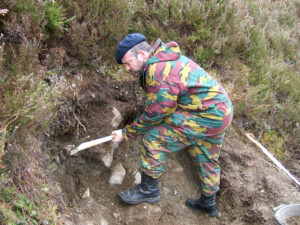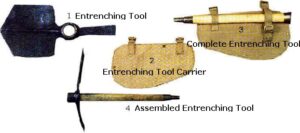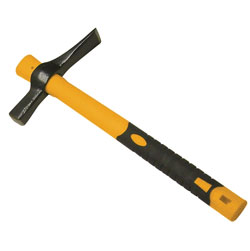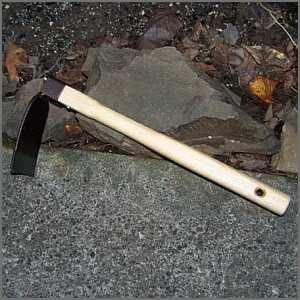If you ask most people to name a digging tool they will probably say “spade” or “shovel”. A couple of them may have said “Entrenching tool” but they were probably thinking of a spade or shovel based implement.

Some time back I was watching a nature program that was discussing how well designed badgers were for digging. They have powerful chest muscles and their claws rake the earth and throw the spoil between their legs. Many other animals use the same method. The program also discussed the mole. The mole uses a swimming motion to move through the earth that pushes the earth to the sides. The mole uses a breaststroke rather than a doggy-paddle action, but the basic mechanism is the same: pull down the earth and scoop it away.
If we once again consider the shovel, it will become apparent that it generally does not use these actions.
Shovels are mainly used to lift and move materials rather than pulling them and letting gravity assist.
Many experienced gardeners and labourers will tell you that the shovel is not their digging implement of choice and that their preference is the pick, hoe, adze or mattock.
I have been told that the most efficient way to dig a foxhole is with a three-man team. One man breaks the soil with a pick, the other two use spades to remove the loose soil. The fourth member of the fire team stands watch and these duties are rotated to minimise fatigue and get the job done in the shortest time.

The entrenching tools issued to most armies have generally been some form of spade.
A notable exception was that of the British Army in the Second World War. This was the '37 Pattern tool, a evolution of the Sirhind 1908 pattern.
While this is not as elegant as some one-piece or folding tools it is very cleverly designed. When assembled the head of the tool is at right angles to the shaft, forming a pick and a very wide-bladed hoe.
The head on its own could be used as a shovel to move loose soil, the pick part sometimes wrapped in a sandbag as a grip.
The end of the wooden handle had a fitting so that a spike bayonet could be fitted to form a serviceable mine probe. The handle itself could be used as a truncheon.
For completeness I will point out that this wasn’t the only entrenching tool issued to British infantry. If the 37 Pattern has one flaw it is that it is a somewhat bulky and unwieldy shape to carry assembled so was not the best choice as close combat weapon.


The modern infantryman typically has a spade-type entrenching tool. It may be folding and capable of using the head in a mattock/hoe configuration and it may or may not have a pick fitting to break up hard soil.
Alternately a fire team may carry a selection of tools such as a pair of shovels, a pick-mattock and a hand axe.
Most outdoorsmen do not need such extensive earth-moving capability unless they are in certain climates or environments. Most of the time an outdoorsman’s digging requirements are simpler: cat holes and Indian wells.
What tools most effectively meet these needs?
The simple hand-trowel is the first solution that springs to mind. You can get these at the local garden centre or hardware store, or certain outdoor suppliers will sell you a lightweight polymer/plastic example. While these are an option they are somewhat limited if the ground is hard or you need to dig a bigger hole than you anticipated.
Personal security is always something you should consider, so I’d like a tool that can also provide me with some defensive capability if needed.



A web-search for “hand-hoe” or “hand-mattock” turns up a number of interesting tools, many of them under a pound in weight and small enough to be carried in a daysac. Some of these are small varieties of pick-mattock while others, intended for gardening combine a hoe with fork tines.
For general camping (as opposed to military needs) my preference is more towards an example that combines a hoe blade with a flat hammer face that can be used for knocking in pegs and stakes. Such a tool can also be used as a useful prying-device, lever or hook for extracting stubborn pegs too.
My preference would also be for a hoe blade with a point, like a trowel but I have yet to see any examples that have this combined with a hammer surface. The “camping hoe” is a possible niche in the market I suspect.